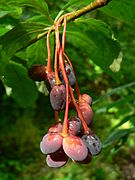Oemleria
| Oemleria | |
|---|---|
| | |
| Scientific classification | |
| Kingdom: | Plantae |
| (unranked): | Angiosperms |
| (unranked): | Eudicots |
| (unranked): | Rosids |
| Order: | Rosales |
| Family: | Rosaceae |
| Subfamily: | Amygdaloideae[1] |
| Genus: | Oemleria |
| Species: | O. cerasiformis |
| Binomial name | |
| Oemleria cerasiformis (Torr. & Gray ex Hook. & Arn.) Landon | |
| Synonyms[2][3][4] | |
| |
Oemleria cerasiformis, a shrub commonly known as osoberry[5] or Indian plum,[6] is the sole species in genus Oemleria.
Native to the Pacific coast and ranges of North America, from British Columbia, Canada to Santa Barbara County, California, U.S.A.,[6] it is among the first plants to leaf out and flowers early in the spring. It reaches a height of 1.5–5 m and has lance-shaped leaves 5–12 cm long.
The fruits of osoberry are edible and resemble small plums which are dark blue when ripe.[7] Indigenous peoples of the Americas include osoberry in their diets, make tea of the bark, and chew its twigs to use as a mild anesthetic and aphrodisiac.[8]
Description
Osoberry is an erect, loosely branched shrub reaching 15 feet (4.6 m) in height. Leaves are alternate, simple, deciduous; generally elliptical or oblong, 2–5 inches (5.1–12.7 cm), light green and smooth above and paler below; margins are entire to wavy; fresh foliage smells and may taste like cucumber. Among the first plants to leaf-out in the spring. The plants are dioecious;[9] male and female flowers occur on different plants. The flowers are whitish-green, bell-shaped, often appear in late winter before the leaves, and are about 1 cm across. The bitter-tasting fruit occurs in ovoid drupes up to 0.5 inches (1.3 cm) long, orange or yellow when young but blue-black when mature; borne on a red stem. The twig is slender, green turning to reddish brown, pith chambered, conspicuous orange lenticles. Bark is smooth, reddish brown to dark gray.[9]
Images
-
Fruits of O. cerasiformis
-
An Indian plum shrub as its leaves begin to yellow in mid-summer, Pierce County, Washington
References
- ↑ Potter, D., et al. (2007). Phylogeny and classification of Rosaceae. Plant Systematics and Evolution. 266(1–2): 5–43. [Referring to the subfamily by the name "Spiraeoideae"]
- ↑ "The Plant List: A Working List of All Plant Species".
- ↑ "The International Plant Names Index entry for Nuttallia Torr. & A.Gray ex Hook. & Arn.".
- ↑ "The International Plant Names Index entry for Osmaronia Greene".
- ↑ "BSBI List 2007" (xls). Botanical Society of Britain and Ireland. Archived from the original on 2015-02-25. Retrieved 2014-10-17.
- ↑ 6.0 6.1 "USDA PLANTS Profile: Oemleria cerasiformis".
- ↑ Turner, Nancy J. (1995). Food Plants of Coastal First Peoples. UBC Press. p. 114. ISBN 9780774805339.
- ↑ Pojar, Jim; Andy MacKinnon (2004). Plants of the Pacific Northwest. Lone Pine Publishing. p. 72. ISBN 978-1-55105-530-5.
- ↑ 9.0 9.1 "Oemleria cerasiformis Fact Sheet". Virginia Tech.
External links
-
 Media related to Oemleria at Wikimedia Commons
Media related to Oemleria at Wikimedia Commons - Jepson Manual Treatment
- Photo gallery

